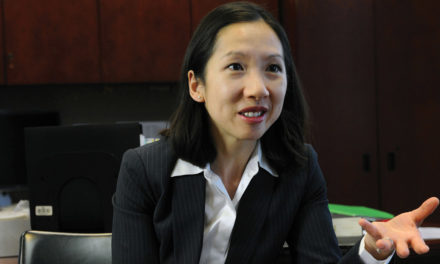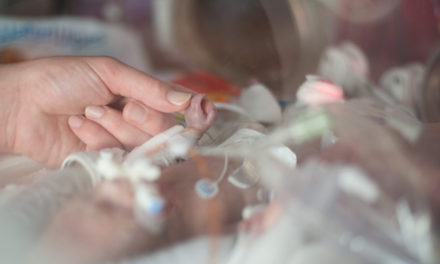Tom Glessner was getting to be a familiar face at the U.S. Supreme Court by the end of June.
He’d shown up five days in a row, making the hour-long commute from his Fredericksburg, Va., home to Washington, D.C. “I was getting to know people there,” he says. ” ‘Good morning, Mr. Glessner,’ they’d say. ‘Hope it comes down today.’ “
“It” was the ruling in National Institute of Family and Life Advocates v. Becerra—a battle between pro-life pregnancy centers and the state of California. At issue: A 2015 law requiring those centers to post prominent notices directing visitors to “free or low-cost access to family-planning services” including abortion. Glessner’s stake: He was president of NIFLA, a legal alliance representing nearly 1,500 pregnancy centers nationwide—most of them licensed medical clinics and roughly one-tenth of them in California.
When Glessner sat down in the courtroom on June 26—the last day of the session—he knew it had to be the day the ruling would come down. When he saw it was to be delivered by Justice Clarence Thomas—a longtime champion of the Constitution’s original intent—he knew his group had won.
What he didn’t know at first was how big a win it was.
He found out shortly afterward, when he talked with Kristen Waggoner, a senior vice president at Alliance Defending Freedom (ADF), one of the groups which had worked alongside NIFLA on the case.
“Kristen had a chance to read it before I did,” Glessner says. “She said, ‘This is the most superb, phenomenal opinion we could get. It’s beautiful.’ “
Although the voting margin was small (5-4), the Court was emphatic. The ruling by Thomas and a concurring opinion by Anthony Kennedy—both of them joined by Chief Justice John Roberts, Samuel Alito and Neil Gorsuch—took strong stands against compelled speech and for freedom of conscience. (For more on what the Court said, see “Going Out on a High Note,” page 14.)
The upshot: The ruling not only protects pregnancy centers in California, but likely will lead to similar protections for other centers nationwide—some of which face similar laws.
“It was a great day,” says ADF Legal Counsel Elissa Graves, part of the team that worked the case. “I’ve been working with pregnancy centers for years, and they’ve been worried that they’ll be attacked the way those in California were.
“Now they’re very excited. So am I. It’s the biggest victory I’ve been a part of.”
Taking It to the Top
To understand the full significance of this ruling, you have to know some history.
“For more than 30 years, the abortion industry—led by Planned Parenthood—has vowed to shut down pro-life centers,” Glessner says. “They’ve tried lawsuits, legislative actions and slander in the media. Those efforts basically have all failed.”
In recent years, bills similar to California’s were stopped short of floor votes in Maryland, Oregon and Washington. Local ordinances passed in several places (Austin, Texas; Baltimore and Montgomery County, Md., and New York City) have been thwarted in court.
Then California came into the picture.
In October 2015, Gov. Jerry Brown signed AB 775, dubbed the Reproductive FACT (Freedom, Accountability, Comprehensive Care and Transparency) Act. Under that law, facilities whose primary purpose is “providing family planning or pregnancy-related services” had to post this notice:
“California has public programs that provide immediate free or low-cost access to comprehensive family planning services (including all FDA-approved methods of contraception), prenatal care and abortion for eligible women. To determine whether you qualify, contact the county social services office at [telephone number].”
The law required posting the notice prominently, going so far as to dictate type size (in licensed facilities, at least 22-point type on a sheet at least eight and a half by 11 inches; in centers without a licensed medical provider, at least 48-point type—and in public ads, type larger than the surrounding text). Penalties were $500 for a first offense, $1,000 for each subsequent one.
From the moment the bill was introduced, Glessner was alarmed.
“I didn’t feel good about the chances of stopping this one in California,” he says. “I thought it would pass, and I knew a federal-court challenge would go to 9th Circuit”—notorious for being the most leftist federal circuit in the country.
“Even as we were fighting it in the Legislature, I was thinking, ‘We’re taking this all the way to the top—to the U.S. Supreme Court,’ ” Glessner says.
The reasons for his alarm weren’t confined to the Golden State.
“If our opponents succeeded in California, they’d have a model that could be duplicated and spread across the country,” he explains. “Not only for legislators sympathetic to the abortion industry, but also for attorneys general who’d launch harassing actions against the centers.
“It would have opened the floodgates for a war of annihilation against pregnancy centers. That’s what made this case so monumental: In many places, the fate of the pregnancy-center movement hung in the balance.”
Shock Waves
As if to confirm that fear, other states (Illinois in 2016, Hawaii in 2017) passed similar measures, even before California’s had completed its passage through the courts.
The people who worked at the pregnancy centers were stunned. Like Stacey Jimenez, executive director of A Place for Women in Waipio (Hawaii), a ministry of Calvary Chapel Pearl Harbor and a NIFLA member.
“When we originally heard about the bill, we didn’t see how it could go through,” she says. “It was compelled speech. It was such a clear violation of the First Amendment.
“When it did go through, we knew we had to fight it.”
Naturally, though, the shock waves were felt most strongly back in the Golden State.
“There was almost a panic in some circles,” Glessner says. “Some doctors were resigning from pregnancy centers to avoid this conflict. Other centers were being advised by some groups, ‘Just comply and we’ll have to live with it.’ “
But the spirit of resistance was strong, too. NIFLA members and other centers launched four separate federal lawsuits. One—Go Mobile for Life, a mobile clinic in Riverside County—embarked on a state-level lawsuit, which succeeded in winning a stay on the law in October 2017. (See “Free Speech vs. Forced Speech,” in the January/February 2018 issue.)
“My first reaction (when the FACT Act was signed) was what I said later on in a press release: ‘I will not post that notice in our clinic,’ ” says Scott Scharpen, president of the Scharpen Foundation, which operates Go Mobile for Life. ” ‘I would rather close the clinic than post that notice.’ “
Among many people working at the centers, that determination was fueled not only by pro-life conviction, but also by a strong bond with their colleagues—their brothers and sisters who’d been in the trenches together for so long.
Ask Glessner, who founded NIFLA 25 years ago.
“We’ve worked especially closely with people in California, where we’ve faced so much hostility,” he says. “So when this law came up, it felt like more to me than defending our members. It was like defending my family.
“When someone attacks your family, you get pretty irate. It wasn’t just professional for me. It was personal.”
‘The Constitution Still Matters’
As expected, the 9th Circuit upheld California’s law last October, ruling against NIFLA and the pregnancy centers it represented. But in November, the Supreme Court agreed to take the case.
On March 20, the centers had their day in Court, with ADF President Michael Farris delivering oral arguments and fielding questions from the justices. It’s a day Glessner remembers for what happened not just in the Court, but also outside.
Officially, it was the first day of spring. But winter was hanging on stubbornly. “The weather was miserable—snow, sleet, rain,” Glessner says. “But we had several hundred supporters there that day, and they started gathering at 7 a.m.”
When the arguments finished at 11, Glessner and the other attorneys headed outside to an enthusiastic reception.
“We came out and big cheers erupted,” he says. “Some of those people had been there for four hours while we were sitting in that warm courtroom. I realized that and was just overcome with emotion. These are our people. This is who they are. They have the best hearts. They’re so committed.”
Three months later, when the Court’s ruling came down, they had a lot more to cheer about.
“When I got the news, I let out a big shout for joy and said, ‘Thank you, Lord!’ ” Scharpen says. “This has been more than a two-and-a-half year journey. All the briefings and analysis and prayer and fasting—it all came to this. Justice was served. Freedom was preserved. And lives will be saved. Babies will be born who would not have been if this law had been upheld.”
“It was such a relief,” Jimenez says. “The Constitution still matters. Now we can continue the mission God has given us without fear of these laws. We can keep serving the people who come to us for help without violating our conscience.”
It’s a safe bet. Although NIFLA v. Becerra dealt with a California law, the decision applies nationwide. Graves predicts the Illinois and Hawaii laws—both of which have not yet been enforced due to separate court challenges—will soon be gone for good, as their opponents move for summary judgment or permanent injunctions based on the ruling.
The Court didn’t really set a precedent in NIFLA, Graves said. It just upheld one.
“The Supreme Court has continuously held that you cannot be forced to speak a message you disagree with,” she says—noting that even during the patriotic fervor of World War II, the Court ruled in 1943 that citizens cannot be forced by government to salute the flag or recite the Pledge of Allegiance.
“The First Amendment has long protected not only the freedom to speak, but the freedom not to speak,” Graves explains. “The decision in NIFLA just reaffirmed that standard. That’s why every American—pro-life or not—should celebrate this victory for the freedom to speak without government intrusion.”
For More Information:
Visit Alliance Defending Freedom’s page on NIFLA v. Becerraor NIFLA’s page.
Originally published in the January/February 2018 issue of Citizen magazine.






